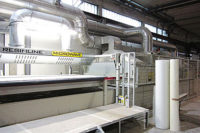
Located beyond the vineyards of Verona, Italy, the Margraf Group of Chiampo, Vicenza, has steadily invested in its stone production. Not only has the company added in a high-tech line for resin-treated slab production within the past few years, but it has also invested in a broad range of equipment for state-of-the-art production of resin-treated marble tiles.
The process for tile production at Margraf begins with blocks, which are trimmed on monoblade saws. After trimming, blocks are processed on Simec blockcutters, which result in strips of 30 mm and 40 mm in thickness - depending on the size of the final tile. (The tiles are ultimately split horizontally, which is why the strips are more than twice as thick as a standard finished tile.) The thick strips coming off the blockcutters are crosscut to the desired size, and they are then calibrated on a Simec LM 600 calibrator.
The calibrated, double-thickness tiles are then resin-treated as needed using products from Tenax S.p.A. of Italy. Since both sides of the strip will ultimately become a finished tile surface, both sides of the tile are treated with the resin products. Large-scale driers are then used to help the resin cure with optimum speed and efficiency. After the resin has cured, the thick tiles are then split horizontally.
From this point, the stone is finished at a new tile finishing plant from Pedrini of Italy, which was installed in March of 2006. The overall concept of Margraf’s new line was inspired by the typical processes of ceramic tile production, with optimum automation at all stages of the process.
During the operation, the split, semi-finished pieces - which have a thickness of about 11 mm - are gauged and pre-polished by a Pedrini line, and the resulting pieces have a thickness of 10.2 mm. The width being processed can be quickly changed by modifying the roller sloping of the system - offering flexibility without reducing overall performance.
A polyester resin product from Tenax is then automatically distributed as needed on the pre-polished surface. Since this resin-application step is for treating very small pores on the marble surface, the line uses Tenax’s Dakos polyester resin, which has a lighter consistency that allows it to “flow” into these small voids with optimum efficiency. Moreover, the Tenax Dakos is UV-activated, so no hardener is necessary.
After the resin is applied, the tiles receive their final polish on a Pedrini B065CV polishing line, which has 20 polishing heads and can accommodate materials as large as 610 x 610 mm (24 x 24 inches).
Two sides of the tiles are then chamfered (beveled), and any possible resin residue is removed from the sides. The workpiece then moves on to a Pedrini M 749 crosscutting unit, which trims the tiles to their exact final size using diamond blades from Tenax. The unit cuts 20 semi-finished pieces during each pass in a time of 33 seconds, maintaining an overall operating speed of 12 meters (39.4 feet) per minute. The last Pedrini unit on the line chamfers (bevels) the two crosscut sides.
Once the tiles have completed the production cycle, they are transferred to an electronic control station to have their dimensions checked, and to ensure that the required quality level has been reached. The tiles are then sorted and classified according to color using a high-tech automated system from SACS Tecnica. This system is able to automatically separate the tiles, and place material within a certain color classification in the designated area. The tiles are then automatically boxed, and the boxes are marked with the relevant information regarding color, type, etc. The boxes of tile are then automatically transported to a staging area of several paletts - with each palett representing a different classification of a single material. The system is able to automatically detect exactly where to deliver each box of tiles, so each palett contains only one variety of material.
Even the paletts themselves are maneuvered around the facility using unmanned forklifts, which can detect when to move a palett to the storage area.
The new line is capable of producing tiles measuring 1 cm thick (roughly 3/8 inch) with widths ranging from 300 to 610 mm (approximately 12 to 24 inches). When processing 300-mm-wide tiles, the line operates at a speed of 12 meters (39.4 feet) per minute, with an overall capacity close to 200 square meters (2,150 square feet) per hour. During an 8-hour shift, the plant is capable of producing 1,500 square meters (over 16,000 square feet) of finished tiles. Due to the extremely high level of automation in the plant, these production totals are achieved with only five employees working in the plant.



